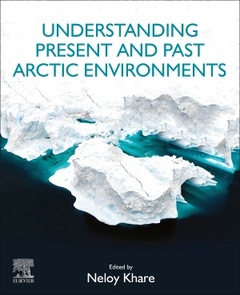Description
Understanding Present and Past Arctic Environments
An Integrated Approach from Climate Change Perspectives
Coordinator: Khare Neloy
Language: English
Subject for Understanding Present and Past Arctic Environments:
Keywords
Aerosol; Albedo; Algae; Amplification; Arctic; Arctic Council; Arctic geopolitics; Arctic glaciers; Area change; Atmosphere; Backscatter; Biodiversity; Brown carbon; Carbon monoxide; Clay minerals; Climate change; Climate indices; Climates; Cooperation; Correlation; Cryptogams; Dissolved organic carbon; Dissolved organic matter; Diurnal cycle; Fjords; GMCIMS; Geoeconomics; Glacier; Global warming; Grain size; Holocene; Induced earthquakes; Lakes; Last Glacial Maximum; Late Quaternary; Magnetic susceptibility; Marine archives; Mass balance; Mass change; Measurements of carbon monoxide; Metals; Microtexture; Microwave scatterometer; Monsoon; Northern hemisphere; Ny-Alesund; Ny-Ålesund; OI-SST; Ocean; Ocean circulation; Organic matter; Paleoclimate; Palynology; Polar regions; Protein-like substances; Quartz grain microtexture; RMS; Remote sensing; Resource competition; SDG; Sea ice; Sediment; Snow; Snowmelt onset; South Asia; Speleothems; Spitsbergen; Sustainability; Svalbard; The Himalayan glaciers; Trend; UV-B radiation; UV-absorbing pigments
520 p. · 19x23.4 cm · Paperback
Description
/li>Contents
/li>Biography
/li>Comment
/li>
Understanding Present and Past Arctic Environments: An Integrated Approach from Climate Change Perspectives provides a fully comprehensive overview of the past, present and future outlook for this incredibly diverse and important region. Through a series of contributed chapters, the book explores changes to this environment that are attributed to the effects of climate change. The book explores the current effects climate change has had on Arctic environments and ecosystems, our current understanding of the effects climate change is having, the effects climate change is having on the atmospheric and ocean processes in this region.
The Arctic region is predicted to experience the earliest and most pronounced global warming response to human-induced climatic change, thus a better understanding is vital.
1. Climate changes over Arctic-Impacts and Assessment 2. India's scientific endeavours in the Arctic with particular reference to climate change: The past decade and future perspectives 3. Lakes and Fjords: Potential indicators of climate change 4. The changing climate and environment around Ny-Alesund, Svalbard, since the Last Glacial Maximum 5. Ocean circulation in Northern high latitude and its influence on Arctic climate through ages 6. Teleconnection between Arctic climate and tropical Indian monsoon during the Holocene 7. Deciphering palaeoclimatic fluctuations through diamictite granulometry and geochemistry, 8. Reconstruction of Quaternary climate in Svalbard:CRN as proxy 9. Ultraviolet radiation protecting pigments in plants growing in the Arctic region 10. Cyanobacterial diversity in the Arctic region: Past reflections and recent trends 11. Arctic biodiversity amidst looming climate apocalypse: Current status and way forward 12. Mass balance and Spatio-temporal change in the area of Vestre Broggerbreen glacierNy-Ålesund, Svalbard, Arctic, between 1993-2018 13. Spatiotemporal variability of snowmelt onset across Svalbard inferred from scatterometer data (2000-2017) 14. Arctic sea ice variability and trends in the last four decades: Role of Ocean-atmospheric 15. Space weather phenomenon of polar ionosphere over the arctic region 16. Optical properties of brown carbon (BrC) in aerosols and surface snow at Ny- Ålesund during the polar summer 17. Signature of increase carbon monoxide during ozone depletion event at Himadri Indian Arctic station 18. Spatial and Temporal variability of physical parameter around Ny-Alesund region of Arctic 19. Geopolitical and Geoeconomic Implications of Climate Change in the Arctic Region: The Future of Contestation and Cooperation 20. Glacial Mass Change Induced Earthquakes in the Himalayan Region of South Asia and its bearing to understand Arctic glaciers dynamics: Proxy of Climate Change
- Presents a thorough understanding of the Arctic, it’s past, present and future
- Provides an integrated assessment of the Arctic climate system, recognizing that a true understanding of its functions lies in appreciating the interactions and linkages among its various components
- Brings together many of the world's leading Arctic researchers to describe this diverse environment and its ecology




